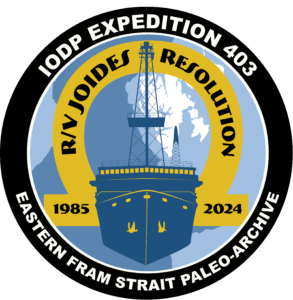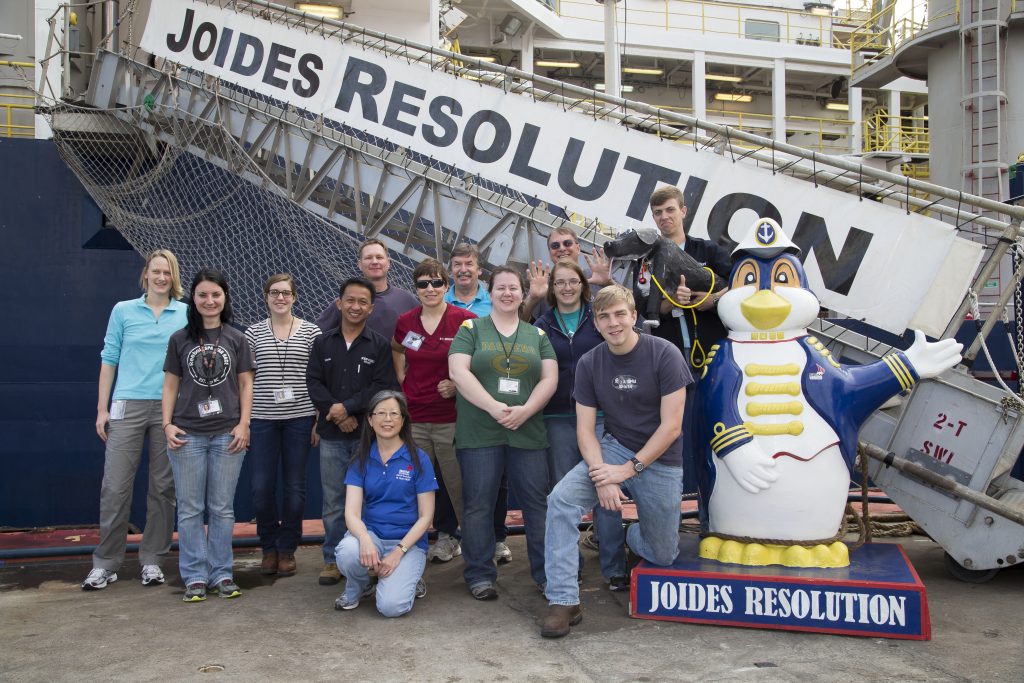3.4 JOIDES Resolution
As the Deep Sea Drilling Project (DSDP) concluded in 1983, so did the participation of Glomar Challenger in scientific ocean drilling activity. The next phase of scientific ocean drilling, the Ocean Drilling Program (ODP), signaled further broadening participation to the international community and included a new ship, JOIDES Resolution.
The ship that became JOIDES Resolution (also referred to as JR) was originally constructed in 1978 in Halifax, Nova Scotia, for petroleum exploration. Originally named Sedco/BP 471, this ship was brought to Pascagoula, Mississippi, in the fall of 1984 to be converted for scientific ocean drilling with the necessary laboratory spaces and ocean drilling and recovery equipment. The ship was renamed JOIDES Resolution in January 1985 at the start of ODP in honor of Captain James Cook’s flagship of two centuries ago, HMS Resolution. As a riserless drilling platform, the JR utilized continuous wireline coring and logging techniques in the recovery of ocean sediments and crustal material and geophysical data. The JR continued its drilling activities through the Integrated Ocean Drilling Program (IODP, 2003-2013). The participation of JOIDES Resolution in the International Ocean Discovery Program (IODP) began in 2013 and concluded with the end of IODP in 2024. The final IODP expedition for the JR was Expedition 403 (Eastern Fram Strait Paleo-Archive, June 4 – August 2, 2024).
Final expedition patch for the final IODP JOIDES Resolution expedition

IODP Expedition 403 started with JOIDES Resolution sailing into the Fram Strait, a passage between Greenland and Svalbard, and ending with the JR closing out an incredible career with ODP/IODP/IODP. This final expedition in 2024 collected crucial data to ground-truth climate models of projected future CO2, temperature, ocean circulation, sea ice, and present Earth ice sheet stability. Blog posts and multimedia material published during the expedition is available at the Expedition 403 JOIDES Resolution and JOIDES Resolution Science Operator websites.
Although the EXP 403 patch shows a gold omega (omega is the final letter of the Greek alphabet and typically means the end of something), the legacy and legend of the JR will continue far past its final voyage at sea.
Finding Your Way Around The JR
Future chapters will detail the different laboratories and analyses conducted on board JOIDES Resolution, but here we are introducing you to the various decks and facilities located on the ship that is 470 feet in length, 70 feet wide, and has a drilling derrick that extends 190 feet from the water line to the top of the derrick.

Floor plans of various decks on JOIDES Resolution. (Credit: JOIDES Resolution Facilities, IODP JRSO, CC BY 4.0)
A Day on the JR
You will learn more about the living and working conditions on JOIDES Resolution as well as its predecessor Glomar Challenger through the audio and video files embedded on the pages in this book. But if you would like to start with a quick snapshot of living and working on the JR, view this video below. click here to explore a 360-degree video of this drillship in YouTube.
Exercise – Bay of Bengal

Read through this EOS article, titled The Search for the Severed Head of the Himalayas and answer the following questions:
a) What were the research objectives defined by the scientists? What were they trying to learn?
b) What was the role of JOIDES Resolution in this investigation? Why was it important to utilize the JR and scientific ocean drilling to accomplish their research objectives?

